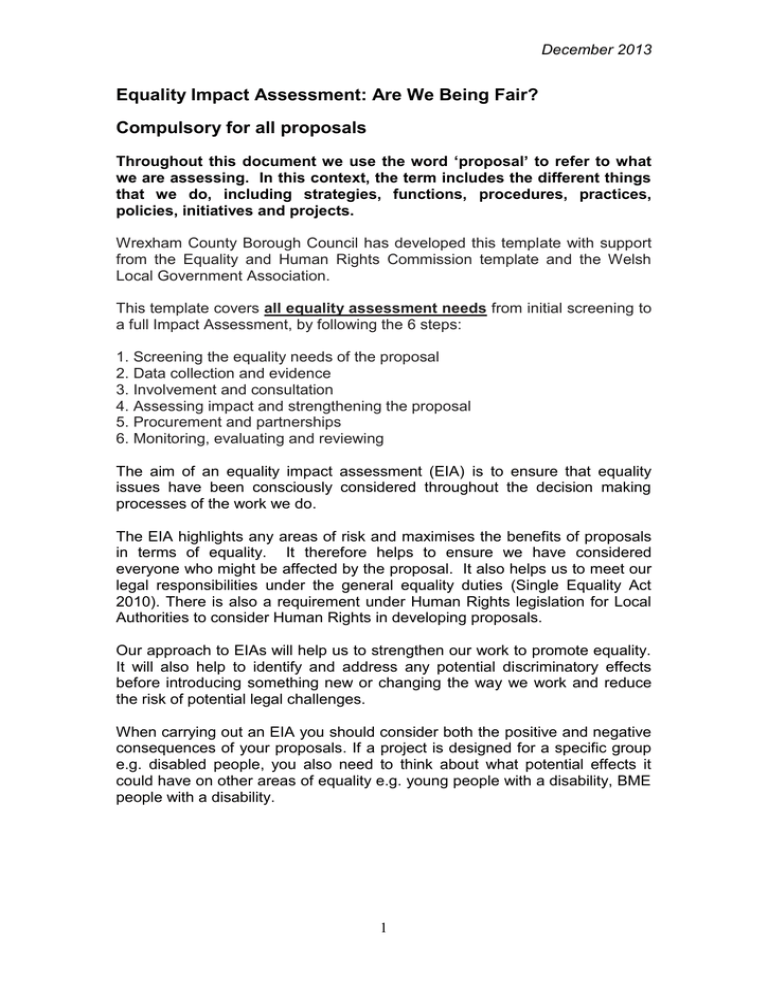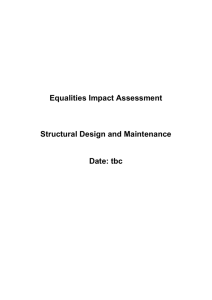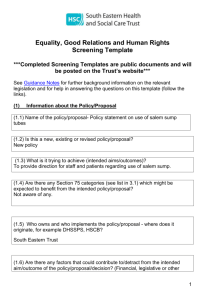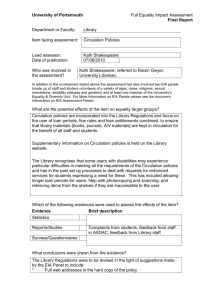Repatriation/Review - Wrexham County Borough Council
advertisement

December 2013 Equality Impact Assessment: Are We Being Fair? Compulsory for all proposals Throughout this document we use the word ‘proposal’ to refer to what we are assessing. In this context, the term includes the different things that we do, including strategies, functions, procedures, practices, policies, initiatives and projects. Wrexham County Borough Council has developed this template with support from the Equality and Human Rights Commission template and the Welsh Local Government Association. This template covers all equality assessment needs from initial screening to a full Impact Assessment, by following the 6 steps: 1. Screening the equality needs of the proposal 2. Data collection and evidence 3. Involvement and consultation 4. Assessing impact and strengthening the proposal 5. Procurement and partnerships 6. Monitoring, evaluating and reviewing The aim of an equality impact assessment (EIA) is to ensure that equality issues have been consciously considered throughout the decision making processes of the work we do. The EIA highlights any areas of risk and maximises the benefits of proposals in terms of equality. It therefore helps to ensure we have considered everyone who might be affected by the proposal. It also helps us to meet our legal responsibilities under the general equality duties (Single Equality Act 2010). There is also a requirement under Human Rights legislation for Local Authorities to consider Human Rights in developing proposals. Our approach to EIAs will help us to strengthen our work to promote equality. It will also help to identify and address any potential discriminatory effects before introducing something new or changing the way we work and reduce the risk of potential legal challenges. When carrying out an EIA you should consider both the positive and negative consequences of your proposals. If a project is designed for a specific group e.g. disabled people, you also need to think about what potential effects it could have on other areas of equality e.g. young people with a disability, BME people with a disability. 1 December 2013 Department Departmental reference number for this EIA [Please contact HoD secretary] Responsible Officer Adult Social Care e-mail address Sheila.finnigan-jones@wrexham.gov.uk Full job title Head of Service Learning Disability Review individuals placed out of County and resettle back to Wrexham Historically a small number of individuals with learning disabilities and complex needs been placed in Out of County placements. This has been due to a lack of local provision to meet their needs. The placements have traditionally been expensive to fund and have not always achieved positive outcomes for the individual. Services have proved difficult to review and it is also difficult for families to maintain contact with their family member. Title of Proposal or Policy Rationale: Why is it being considered? What need is being addressed? ASC / EIA 017 Sheila Finnigan-Jones National drivers following an enquiry into the abuse of residents at Winterbourne View an Independent Hospital for people with a Learning Disability in England has led to an action plan being developed across Wales with the focus being placed on developing quality local services with a clear plan for individual’s to return to their local area where appropriate. Based on individual need more appropriate and informed commissioning of services will focus on positive outcomes for the person and their families and afford the opportunity to make efficiencies in delivery. Aim: What is the intended outcome of the proposal / policy? A more local reviewing process can be developed to ensure the delivery of quality services focussed on progression towards independence and involvement in local communities. Stronger safeguarding links will be established. Local commissioning can include the use of effective Assistive Technology to enhance independence. How: How will it be delivered, by whom and by when? A Regional Group across the 6 North Wales Authorities and including the Betsi Cadwaladr University Health Board (BCU) has been established so that work can be undertaken in partnership. Work has already taken place to identify all individuals known to Health and Social Care in Out of County Placements. Individual reviews will be undertaken to establish need jointly with health practitioners where appropriate. Accommodation will be accessed/developed to meet 2 December 2013 need. Support will be commissioned via the Authorities procurement process to meet identified need. Joint funding and commissioning with BCU will be undertaken where appropriate. Who: Who are the people likely to be affected by this proposal or policy? Individuals 18+ with Learning Disability and Complex needs who are currently place in Out of County Placements . How have you consulted with the people who are likely to be affected? Consultation plan to be developed as part of the project plan. Measures: People we support will have moved back to their local area into suitable accommodation that meets their current and future support needs. Have more appropriate levels of support to meet their needs without being over-supported. How will you know you have achieved your aims? What are your measures / indicators of success? More effective safeguarding framework developed More effective use of resources. Identify any other policy or decision [internal or external] that may affect your proposal. Consider this in terms of: Statutory requirements; local policies e.g. WCBC Housing Policy; Regional decisions e.g. those made by cross county partnerships for your sector e.g. North Wales Chief Officers Board; and / or National policies e.g. Welfare Reforms The Council’s Reshaping services programme particularly: Transport Review Reduction in supporting people funding National Policies Changes to Welfare Benefits Changes to CHC/joint funding policies Limiting of Special Needs Housing Grant. 3 December 2013 Screening Tool As part of our Annual Equality Return we have to evidence what we have actively done to support people with Protected Characteristics who receive our services. We also have to evidence what we are doing to reduce any negative impact. Note: Poverty and Welsh language and culture are not protected characteristics but we have included them because they are important considerations. Please place a ‘+’ or ‘-‘symbol in every box to indicate whether your proposal will have a positive or negative affect note: people may have one or more of the protected characteristics. If there is no impact at all place ‘n/a’. If there is a positive and negative effect indicate both i.e.. ‘+/-‘: Q1 Would this proposal significantly affect how functions are delivered to any of these groups? Q2 Would this discriminate against any of these groups? Q3 Would this proposal advance the equality of opportunity for these groups? Q4 Would this promote good relations between these groups and the wider community? Carers Age CYP Age Adults 18+ Disability Gender / Sex Race/ Ethnicity Religion or Belief Sexual Orientation Marriage and Civil Partnership Gender Re assignment Poverty Welsh language / culture N/A N/A + + N/A N/A N/A N/A N/A N/A N/A N/A NO N/A NO NO NO NO NO NO NO NO NO NO NO N/A N/A + + + + + + + + + + + N/A N/A + + + + + + + + + + + Pregnancy and Maternity N/A 4 December 2013 Where you have identified a positive impact (+) in the Screening Tool, please outline this briefly using bullet points: 1. Positive Impact of Service Users & Carers There is an opportunity for service users to progress to more independence. There is an opportunity for service users to have more choice, control and flexibility based in local service delivery. o There is an opportunity for service users to experience local community inclusion and community presence Stronger safeguarding links will be established. 2. Positive Impact on Communities It is recognised that a range of support will be required and we aim to make greater use of partnerships, community facilities and activities and aim to meet the needs of those whom are traditionally hard to reach groups / seldom heard communities and / or socially disenfranchised. Where you have identified no impact (n/a) in the Screening Tool, please outline this briefly using bullet points: The project is specifically relates to Day Services for Adults 18+ and therefore it is not envisaged that there will be any impact to for Children & Young People. 5 December 2013 If you have indicated a possible negative effect on any Protected Characteristic within the screening tool, please complete the relevant sections of the Matrix below that correspond to that possible negative effect. You will need to consider: What is the likely scale of the impact and how this can be reduced? Who are the people that are likely to be affected by this proposal, could they experience multiple disadvantage e.g. if they are young and have a disability. Whilst there is the potential for improved services through the resettlement process, some people may feel that they want their services to remain unchanged in the same place. This will be managed via consultation with service users and their families/advocates/ representatives. Individual transition plans will be devised with the full involvement of the individual; and/or their family/advocate/representative. Individuals may have concerns about moving away from established networks/friendships. This will be managed via consultation with service users and their families/advocates/ representatives. Individual transition plans will be devised with the full involvement of the individual; and/or their family/advocate/representative. 6 December 2013 EIA: Are we being fair? Please complete the relevant sections of the Matrix below that correspond to any ‘-‘ symbols you have recorded in the screening tool List what information you have used to identify these issues e.g. consultation, stakeholder involvement, reports, data … Based on the information you have gathered give a summary of key issues that have been identified. How will you mitigate these issues to improve the service? Who is officer responsible for delivering the mitigation? Which other departments will you work with to achieve this? By when Service Plan Reference N/A N/A N/A N/A N/A N/A N/A N/A N/A N/A N/A N/A Carers N/A N/A N/A N/A N/A N/A Age Adult N/A N/A N/A N/A N/A N/A N/A N/A N/A N/A N/A N/A N/A Pregnancy and Maternity Age CYP Disability N/A. N/A N/A N/A Gender / Sex N/A N/A N/A N/A N/A N/A N/A Race/ Ethnicity N/A N/A N/A N/A N/A N/A N/A N/A N/A N/A N/A N/A N/A N/A N/A N/A N/A N/A N/A N/A N/A Marriage and Civil Partnership N/A N/A N/A N/A N/A N/A N/A Gender Reassignment N/A N/A N/A N/A N/A N/A N/A Welsh Language and Culture N/A N/A N/A N/A N/A N/A N/A N/A N/A N/A N/A N/A N/A N/A Religion or Belief Sexual Orientation Poverty 7 December 2013 Please respond to the following questions within 12 months of implementation of the proposal: a) Was any mitigation applied or was the proposal delivered as originally planned prior to the Equality Impact Assessment? b) Were the intended outcomes of the proposal achieved or were there other results? c) Were the impacts confined to the people you initially thought would be effected, or were other people affected? How? 8






